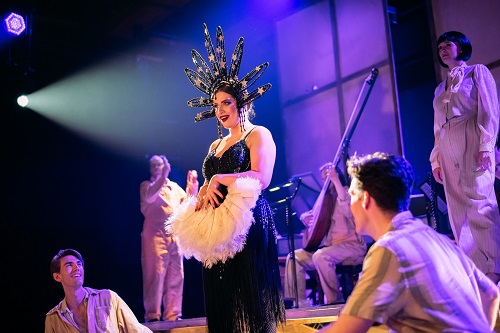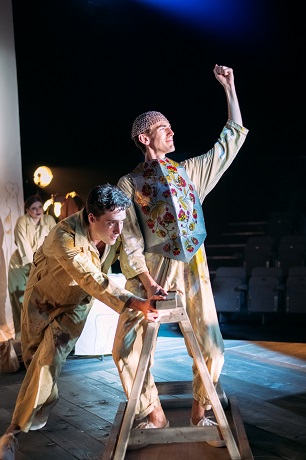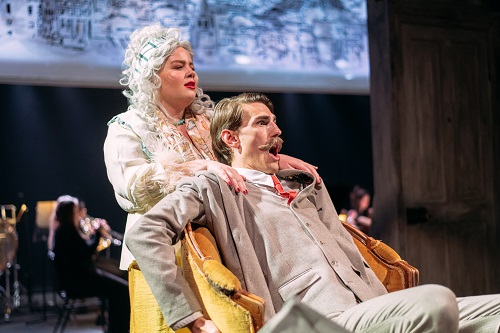The London Conservatoires frequently serve up some of the most interesting operatic fare in the capital: unusual programmes, often in eclectic pairings, presented in inventive stagings – and, of course, they provide the opportunity to hear new voices on their way to bigger platforms and bright futures. So, this double bill of Monteverdi and Weill at the Guildhall School of Music and Drama intrigued. Sadly, dramatically at least, it did not quite live up to its promise.
Influenced by the fact that Weill’s 1927 Zeitoper, Der Zar lässt sich photographieren, takes place in a photographer’s studio in 1914 Paris, director Victoria Newlyn’s guiding concept was ‘the artist making art’, and the first part of the double bill – comprising a series of Monteverdi’s madrigals (mostly from the Eighth Book published in Venice in 1638 as ‘Madrigali guerrieri e amorosi’) concluding with the mock chivalric Il Combattimento di Tancredi e Clorinda which is based on the epic Gerusalemme Liberata – was similarly set in a 1920s studio space. Through a process of workshopping and devising, a scenario had been developed in which a group of musicians, designers, artists and performers, and a famous actress with whom the director had ‘history’, variously sought to impress or show their lack of reverence for their director.
The Silk Street Theatre had been reconfigured into a more intimate traverse space. At one end a raised platform housed a baroque ensemble of strings, violone, two theorbos, baroque guitar and harp, and two harpsichords. Designer Louie Whitemore strewed the rectangular stage-space with a few low wooden tables, chairs and paint pots. Taking off their uniform beige overalls to briefly assume character-roles, the eight soloists marched back and forth, gesturing in a stylised fashion (a nod to theatrical innovator Vsevolod Meyerhold, we were informed). The intent was apparently to explore how the artist ‘intersects with power, politics and personhood’. The to-ings and fro-ings left me utterly perplexed, even though I’d read the scenario beforehand.

As for the singing, Nancy Holt and countertenor Eliran Kadussi proved most comfortable in the idiom and in ‘Zefiro torna’ Zephyr’s ‘accents’ truly were ‘sweet’, set gracefully against a ciaccona ground bass which was crisp but would have benefited from a little more jauntiness. Indeed, the instrumental ensemble could have been let off the leash in these madrigal accompaniments. They were proper and precise, but with the instrumentalists effectively arranged in a line, there was little opportunity for collaborative interaction and spontaneity.
In contrast to the lack of extant information about how Orfeo was to be performed, Monteverdi took the trouble to provide detailed performance instructions for Il Combattimento: Tancredi was to enter on a ‘horse’, Clorinda from the other side; the combat between them was to be depicted in gesture and movement. And, the performance should begin, without warning, straight after the other madrigals in Book 8 which had been sung with no extraneous gestures or movements. The instructions for the instrumentalists were similarly, and unusually, precise, so that they were able to distinguish clearly between loud and soft, calm and excited passions, in imitation of the textual images and emotions. So, we had galloping rhythms, double pizzicatos representing the clash of swords, fanfare-like triadic figures, and rushing scalic runs, all consummately executed.

The performers achieved a good balancing act between narration and dramatic representation. Kadussi deftly negotiated Testo the narrator’s virtuosic account of the fight itself with the intonation only occasionally losing focus. At the close, Jonathan Eyers (Tancredi) and Louisa Stirland (Clorinda) persuasively conveyed their expanding gamut of emotions. Throughout there was a vivid vocal and physical energy of the type that Monteverdi was not to attempt to present on stage again.
Der Zar lässt sich photographieren, which Weill intended to serve as a buffo companion piece for his first surviving opera, Der Protagonist, had more dramatic focus and form. Georg Kaiser’s libretto tells of the Tsar’s arrival at the famous photographer Angèle’s studio in Montmartre. Some easels and rugs set the scene, the door by which the Tsar makes his fox-trot entrance stationed at the non-platform end of the traverse with the orchestra – playing a new orchestration by former Guildhall Opera School student Vahan Salorian – placed behind it. The stage space didn’t serve the drama well, being too ‘open’ and ‘fluid’, when a more fixed, intimate locale would be preferential: we should be able to anticipate the arrival of the Tsar, or the prior intrusion of the bunch of radical would-be assassins who commandeer the studio, install a ‘False Angèle’ and set up a gun in her camera.

Weill described the Tsar as a characteristic post-war prince, ‘as frequently portrayed in the movies by Adolphe Menjou’, and Jack Holton was a suave royal, stylishly donning the everyday dress in which he wants to be captured on camera, and singing with an elegance that did not hide his rather base amorous intentions. Erin Gwyn Rossington had seemed pushed rather high in the Monteverdi madrigals but here she was a valiant and vibrant ‘False Angèle’, easing into the role with aplomb. As the revolutionary leader, Jack Dolan was fittingly passionate and intense. The off-stage male chorus also made their mark, although Weill instructed that they should be situated in the orchestra, humming and pointing to things which the protagonists are unaware, such as the cloth covering the loaded gun, a dramatic irony that was lost here.
The score is through-composed and there are plentiful pre-echoes of the characterful ostinatos and funeral marches of Aufstieg und Fall der Stadt Mahagonny in the vibrant orchestral writing, but Weill imports the music of the age in the form of two set number: the Tsar’s fox-trot entrance music and the ‘Tango Angèle’ of the climactic gramophone scene when the assassins, alerted that they’ve been busted, practise a fake seduction upon the Tsar – winding up the gramophone in a faux prelude to anticipated eroticism – so that they can make a quick escape. Singers and musician milked the comic tension that is present as much in the music as it is in the verbal puns and dramatic ironies.
The challenge is to marry the satirical with the farcical – in the spirit of opera buffa. I’m not sure that Newlyn and the young Guildhall singers and musicians quite pulled that off but, led assuredly by conductor Chris Hopkins, they gave us a witty and engaging entertainment.
Claire Seymour
Monteverdi: ‘Mentre vaga Angioletta’ (Erin Gwun Rossington, Faryl Smith), ‘Armato il cor’ (Jonathan Eyers, Jack Holton), ‘Ardo e scoprir’ (Louisa Stirland, Inguna Morozova), ‘Zefiro torna’ (Nancy Holt, Eliran Kadussi), ‘O come vaghi’ (Jonathan Eyers, Jack Holton), ‘Se vittorie sì bella’ (Erin Gwyn Rossington, Faryl Smith); Il Combattimento di Tancredi e Clorinda (Testo – Eliran Kadussi, Clorinda – Louisa Stirland, Tancredi – Jonathan Eyers)
Weill: Der Zar lässt sich photographieren
Der Zar – Jack Holton, Angèle – Lorna McLean, Der Gehilfe – Mark Christian Bautista, Der Boy – Aina Miyagi Magnell, Die falsche Angèle – Erin Gwyn Rossington, Der falsche Gehilfe – Hamish James, Der falsche Boy – Alexandra Meier, Der Anführer – Jack Dolan, Der Begleiter des Zaren – Jacob Harrison, Erste Kriminalbeamter – Steven van der Linden, Zweite Kriminalbeamter – Ed Birchinall, Verschwörenen – Benoît Déchelotte/Carlos Felipe Cerchiaro, Offstage Chorus (Harun Tekin, Matias Carbonetti Schwanek, Charles Secombe, Ceri Ellis, Ambrose Chiu, Twm Tegid Brunton, Oliver Williams)
Director – Victoria Newlyn, Conductor – Christopher Hopkins, Designer – Louie Whitemore, Lighting Designer – Jake Wiltshire
Guildhall School of Music and Drama, Silk Street Theatre, London; Monday 6th June 2022.
All images (c) Mihaela Bodlovic.